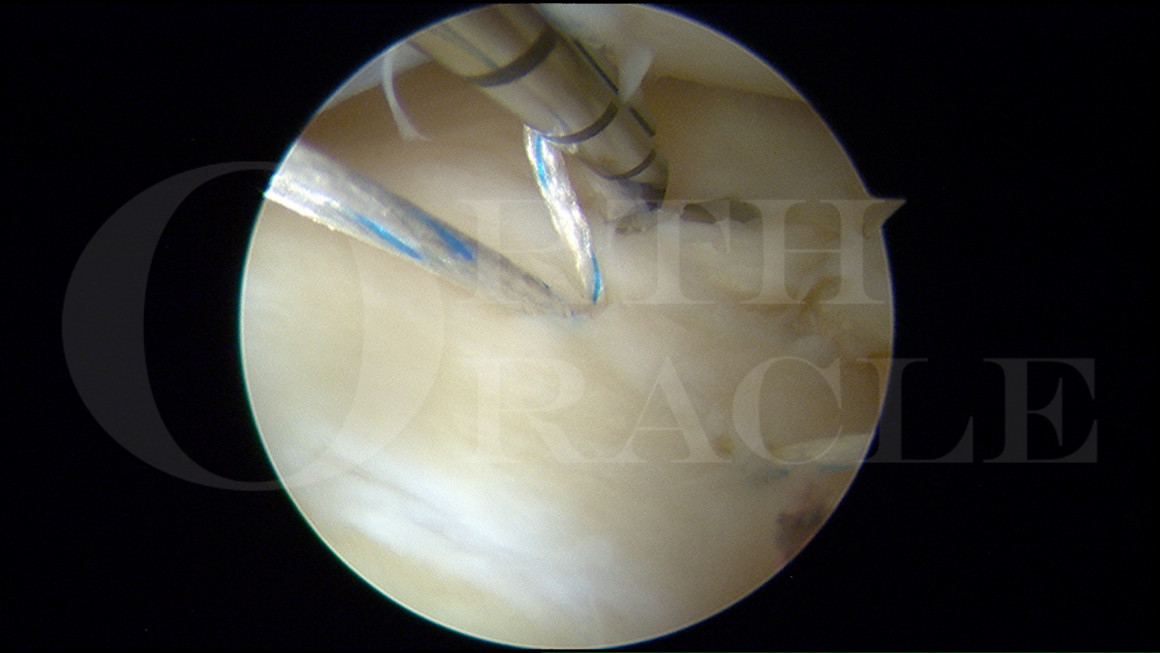Meniscal repair:Arthroscopic technique with fibrin clot, bone marrow aspirate using Smith and Nephew Fast Fix 360 system
Overview

Subscribe to get full access to this operation and the extensive Knee Surgery Atlas.
Learn the Meniscal repair:Arthroscopic technique with fibrin clot, bone marrow aspirate using Smith and Nephew Fast Fix 360 system surgical technique with step by step instructions on OrthOracle. Our e-learning platform contains high resolution images and a certified CME of the Meniscal repair:Arthroscopic technique with fibrin clot, bone marrow aspirate using Smith and Nephew Fast Fix 360 system surgical procedure.
The meniscus is a vital component of the knee whose function is to transmit load over as wide an area as possible between the femur and tibia. Subject to injury in an increasingly sporting population and degenerative change in an increasingly ageing population, meniscal pathology is both common and usually symptomatic.
From the advent of arthroscopic techniques, the meniscus has often been the site of surgical intervention, with meniscectomy or partial meniscectomy the mainstay historically. As arthroscopic techniques have improved, and an understanding of the sometimes deleterious longer term effects of menisectomy has become evident, surgical alternatives to menisectomy have begun to be explored.
This shift in practice has been aided by the implant industry who have both developed devices and also standardised techniques to assist in the task of meniscal repair. The increasing focus on meniscal preservation has led to the recognition of different meniscal tear morphologies not previously recognised, such as the root tear or the meniscal ramp lesion.
A variety of suture techniques are required for those carrying out meniscal repair, suture type being determined by the location of the pathology: For a posterior 1/3 meniscal tear “all inside” devices are ideal (eg The Smith and Nephew Fastfix 360 or the Arthrex Cinch II). The suture is usually an ultra-strong braided 2-0 suture such as Ultrabraid (Smith & Nephew) or 2-0 FiberWire (Arthrex) and the anchors on these devices are usually small (1mm x 2mm plastics (PEEK) or some manufacturers offer all suture anchors where the actual anchor is made of a suture knot. My current preference is for Smith and Nephew FastFix 360 for all inside due to small size of devices, strong suture and ease of use. The predecessor to this was the Smith and Nephew FastFix Ultra which I liked for its flexibility of use, but the anchor was larger and should an anchor come loose in the knee the smaller the better! For inside out sutures my preference is the Arthrex Meniscal Suture tape which allows a tape to be used with less risk of cut-out, and also this sits down flush with the meniscus.
A mid-zone meniscal tear is easiest managed with inside to outside sutures. The anterior 1/3 meniscus often requires outside to inside techniques, to shuttle a suture across the tear. The suture ends are then retrieved through one of the portals anteriorly and tied down to the capsule under arthroscopic visualisation. The choice of suture is surgeon-specific. I have used both Ticron 2-0 (Smith and Nephew) sutures and more recently 2-0 Meniscal Suture Tapes (Arthrex).
Remember always to assess the meniscal root (up to 10mm from the actual bony attachment) as this requires different techniques such as passing a meniscal tape (eg Ultra-tape from Smith and Nephew or FiberTape from Arthrex) with a passing device (eg the First Pass Mini from Smith & Nephew or the Knee Scorpion from Arthrex).
Similarly it is important to assess for capsular detachment of the meniscus (particularly on the medial side) distal to the joint line (ie posterior to the tibia). This can be detected by probing and movement of the meniscus into the joint, or direct visualisation from a postero-medial portal.
Readers will find the following OrthOracle surgical techniques also of interest: Meniscal repair using Smith and Nephew fast-fix 360 system and knee arthroscopy Trans-tibial meniscal root repair using Smith and Nephew Firstpass mini Knee arthroscopy and partial medial menisectomy
Author: James Murray FRCS (Tr & Orth)
Institution: The Avon Orthopaedic Centre, Southmead Hospital, Bristol, UK
Clinicians should seek clarification on whether any implant demonstrated is licensed for use in their own country.
In the USA contact: fda.gov
In the UK contact: gov.uk
In the EU contact: ema.europa.eu
Online learning is only available to subscribers.



















